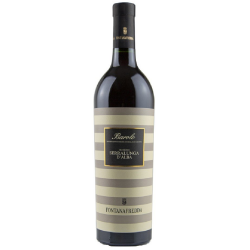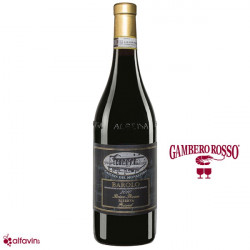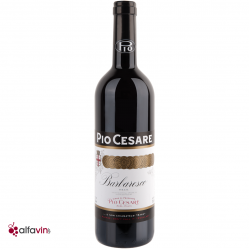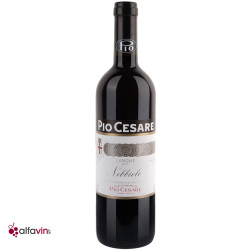If you have never heard the expression "Barolo, king of wines, wine of kings" then this is for you! Probably with Amarone della Valpolicella, one of Italy's best known and most prized denominations of origin. Nestled in the heart of Piedmont, the Barolo vineyard is one of the most beautiful in the region. Known for its gastronomy and in particular the white truffle of Alba, this wine region has many surprises in store for you. In this article we will discuss its history, how men have shaped it to become what it is today, without forgetting to talk about its production and especially the people who make it.
Is Barolo a grape variety?
Well, no, Barolo is a Denomination of Controlled and Guaranteed Origin (DOCG). Instead, the grape variety used to produce Barolo is Nebbiolo. Its name comes from Nebbia, which means fog and refers to the late ripening of this grape variety, which is usually harvested when autumn and its first fogs arrive. It is a late ripening variety, yet it buds relatively early. Nebbiolo is a variety that requires a good exposure, and appreciates soils with clay-limestone dominance. Gustatively, it produces tannic wines, with good alcohol potential and good acidity. Although the wines are best enjoyed in their youth, their aging potential is admirable and the old vintages are often admirable.
The Barolo appellation area is located in the Langhe region. Today there are eleven communes in which Barolo can be produced: Barolo, La Morra, Monforte, Serralunga d'Alba, Castiglione Falletto, Novello, Grinzane Cavour, Verduno, Diano d'Alba, Cherasco and Roddi. In order to obtain the Barolo DOCG denomination and thus protect the appellation, rules have been put in place to guarantee quality, avoid fraudulent copies and protect the work and history of Barolo producers. Only the Nebbiolo grape variety is allowed with a maximum yield of 56 hectoliters per hectare. The wine must have a minimum alcohol content of 13%. Concerning the maturation of the wine, there again precise rules have been enacted. To have the right to the appellation, it is at least two years in barrels followed by one year in the bottle. To become a "reserve" cuvée, a minimum of five years is required, at least three of which must be spent in barrels.
The history of Barolo wine
Even though viticulture has existed for centuries, the history of Barolo with a capital H was really written between the 18th and 19th centuries. Under the impetus of Camillo Benso, Count of Cavour, and Giulia Colbert Falletti, Marchioness of Barolo (who was also the last one), the local winemakers, with the help of external advisors, greatly improved the quality of the wine. Thus, the wines became, thanks to the Savoy family, a worthy representative of the region through the European Royal Courts: the wine of Kings.
In the 20th century, the Barolo winemakers, together with those of Barbaresco, decided to form a consortium to protect their wines. And in 1934, the Consortium for the Protection of the Quality of Local Wines of Barolo and Barbaresco was created. A little later, in 1966 to be exact, the appellation acquired the status of DOC (Denomination of Controlled Origin) and then of DOCG (Denomination of Controlled and Guaranteed Origin) in 1980.
Today, the consortium looks after Barolo's interests throughout the markets, manages the activities related to the appellation and ensures the constant quality of the wines produced.
Discover our Barolo wine list right here.
The production of Barolo wine
Today the production extends over some 2000 hectares and includes 1200 producers. In addition to the rules stated earlier in this article, which define and govern the production and marketing of the wines, there is another point to consider in order to understand the wines of Barolo. Today there are two schools or more precisely two visions in the method of winemaking Barolo. If during the 1980s-1990s, the desire was to produce more tannic and richer wines, from the mid-2000s, the trend has been reversed to produce finer wines, on fruit and freshness. This has been the case in the land of Barolo as in many other countries in the world. Thus, we can say that today we have a traditional and a more modern vision in the mode of production.
If the "traditional school" prefers longer macerations with regular punching of the cap (an action that allows for the extraction of more color and substance), and longer maturation in wood, the "modern school" prefers to opt for shorter macerations in stainless steel tanks, and slightly shorter maturation.
Even if these two schools have a slightly different vision, the quality is always there and most importantly, true to the land.
Alfavin.ch and its Barolos
Switzerland has always been an important market for Italian wines and Barolo is no exception. At Alfavin.ch, we work with several wineries that we present here.
If in the 18th century the current estate was a monastery with Benedictine monks, it is since 1926 that the Grasso family is the owner. Today, Giuseppe and Velda are at the helm and, in addition to wine production, they have developed an agritourism activity. Here are the three vintages available at Alfavin.ch
Barolo "Perno"
Terroir in the district of Monforte d'Alba; south-southeast exposure, sand and clay soil, with layers of gray marl and sandstone. On the nose delicate notes of raspberries and blackcurrants. On the palate, a full-bodied wine with a delicate tannic structure.
Barolo "Bricco Luciani"
Vineyard located between Annunziata and Cascina Luciani, the soil is clay and limestone. This is the wine that makes the pride of the estate. Aged for 48 months in bottle. The nose has notes of ripe fruit, a floral touch and slightly smoky notes. The attack is ample and frank, with an affirmed tannic structure. Long persistence and definitely a wine to be aged.
Barolo "Bricco Rocca"
This is the reserve wine of the estate. Located in Annunziata de la Morra, the vineyards are on clay-limestone soil. The nose is intense and complex, with black fruits, violet notes, spicy and smoky touches. A powerful and harmonious palate that will require time to express its full potential.
Family owned for 5 generations, Pio Cesare has its roots in the development of the appellation in the 19th century. With parcels scattered throughout the vineyards of Barolos and the best terroirs, Pio Cesare and his traditional vision of Barolo make this producer a reference of the appellation.
Barolo DOCG
A Barolo in the purest tradition. A blend of the different terroirs of the estate, this wine is vinified in stainless steel tanks with a 25/30 day maceration and then aged in wood for 30 months. A wine with notes of red cherries, licorice and tobacco, structured and balanced in the mouth. To be aged.
It is surely one of the most beautiful stories of Italy for this estate that was owned by the first king of Italy in 1861, Victor-Emmanuel 2. Since 2008, it is managed by Oscar Farinetti who carefully watches over the 120 hectares of the estate.
Barolo "Serralunga d'Alba"
This wine is made from vines from the Serralunga d'Alba area. This Barolo is vinified with macerations of 15/20 days and then aged for a minimum of 3 years, 2 of which in wood. Nose: rose, vanilla and spices. In the mouth, the wine is full and harmonious.
Discover our articles on Barolo:
Everything you need to know about aging Barolos, Alfavin.ch explains it all!
What to eat with a Barolo? Alfavin.ch tells you everything!
How much does a Barolo Cost?
Discover also our wine subscriptions to offer as gifts or for yourself.









